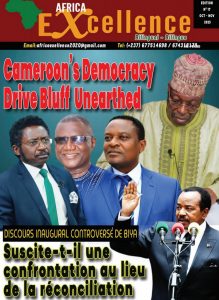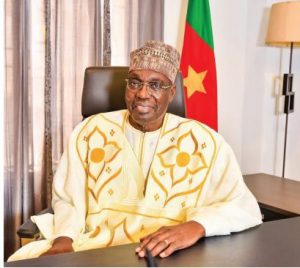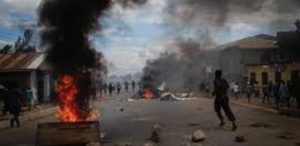
Issa Tchiroma’s Nationwide Lockdown Paralyses Economic Heartlands as Constitutional Crisis Deepens
By Mwalimu McMua
An extraordinary manifestation of civil disobedience has transfigured Central Africa’s most economically significant Francophone nation into a tableau of resistance, opposition presidential candidate Issa Tchiroma Bakary’s summons for a nationwide “ghost town” lockdown has precipitated an unprecedented constitutional conflagration, catalysing geopolitical reverberations which transcend Cameroon’s territorial boundaries and threaten the economic architecture of the entire Central African Economic and Monetary Community.
The outrage commenced following the Constitutional Council’s October 27 proclamation that incumbent Paul Biya‚ at ninety-two years the planet’s most senescent head of state‚ had secured an eighth consecutive mandate with 53.66 percent of ballots cast. This announcement, which would extend Biya’s forty-three-year dominion until 2032, detonated popular fury across the nation’s metropolitan agglomerations, as Tchiroma, who officially garnered 35.19 percent according to the Constitutional Council, vehemently repudiated these figures, asserting his autonomous tallies demonstrated an overwhelming mandate.
The Architecture of Resistance

Tchiroma, a septuagenarian railway engineer who served as Minister of Communication from 2009 to 2019 and Minister of Employment and Vocational Training until June 2025, orchestrated his candidacy with meticulous forethought. After declaring himself victor on October 14, Tchiroma urged the incumbent to “honour the truth of the ballot box” and concede, citing parallel vote tabulations conducted by his Front for the National Salvation of Cameroon (FSNC) through a comprehensive network of polling station monitors who secured procès-verbaux‚ official results sheets‚ from strategic electoral constituencies.
When the Constitutional Council’s adjudication proved antithetical to his expectations, Tchiroma issued an impassioned audio press release on October 31, summoning compatriots to implement a tripartite “ghost town” operation spanning November 3-5, entreating citizens to “keep businesses closed, suspend activities, remain domiciled in silence” as a manifestation of collective repudiation of what he characterised as electoral larceny perpetrated through state machinery.
Urban Landscapes of Defiance
The lockdown’s implementation revealed stark geographical disparities in compliance and intensity. In Douala, Cameroon’s mercantile fulcrum and maritime gateway‚ whose port infrastructure processes approximately ninety-five percent of the nation’s containerised commerce and serves as the indispensable transit conduit for landlocked Chad and the Central African Republic‚ the economic hub witnessed substantial adherence, with shuttered markets and deserted commercial arterials, though food vendors reported severe economic privation.
In Maroua, capital of the Far North Region, the lockdown commenced prematurely on November 1, with over 2,000 market stalls remaining hermetically sealed as merchants voiced trepidation regarding inadequate security provisioning. Garoua, Tchiroma’s septentrional hometown where he cast his ballot, emerged as the symbolic epicentre of resistance, experiencing near-total commercial paralysis while simultaneously becoming a flashpoint for violent confrontations between security apparati and demonstrators.
In Yaounde, the administrative capital, compliance proved more variegated, with certain commercial precincts maintaining operations while commodity prices experienced vertiginous inflation‚ a five-litre receptacle of potatoes escalating from FCFA 2‚000 to FCFA 5‚000 within a week, illustrating the lockdown’s immediate impact on supply chains and household economies.
Ngaoundéré, positioned strategically on the Adamawa plateau as a railway terminus connecting septentrional and meridional regions, witnessed substantial participation, effectively severing critical freight movements essential to national sustenance security. In the western Grassfields municipalities‚ Bafoussam, Bafang, Mbouda, Dschang, and Nkongsamba‚ markets remained predominantly shuttered, demonstrating the Bamileke commercial diaspora’s mobilisation capacity
Bertoua’s participation disrupted trade conduits serving the Central African Republic, while in the Anglophone regions of Bamenda and Buea‚ already traumatised by years of separatist insurgency‚ citizens demonstrated sophisticated capacity for sustained economic disruption, having previously weaponised “ghost town” strategies during the Anglophone crisis.
Violent Suppression and Human Toll
The state’s response proved sanguinary. On the first day‚ Human Rights Watch documented at least four fatalities attributable to security forces, with dozens injured and hundreds detained across multiple urban centres.Issa Tchiroma says more than one hundred persons have been killed since the beginning of the lockdown
Governor Samuel Dieudonne Ivaha Diboua reported that protesters attacked police installations in Douala’s second and Sixth Subdivision, prompting deployment of tear gas and water cannon.
In Banyo, confrontations escalated dramatically when citizens forced an SDO‘s withdrawal, subsequently incinerating the local CPDM party headquarters and ransacking residences of regime officials, signaling the volatility of popular sentiment.
Most alarming were reports suggesting military factionalism. Tchiroma’s legal counsel confirmed that the candidate relocated to an undisclosed “safe location” under protection of what he designated “loyalist” military elements who recognise him as legitimate president, intimating potential schisms within the armed forces that could presage more destabilising scenarios.
Economic Devastation: Quantifying Catastrophe
The lockdown’s economic ramifications proved immediately catastrophic. Cameroon, with a nominal GDP of approximately $49.3 billion and positioned as Central Africa’s economic locomotive, experienced precipitous contractions across multiple sectors. The Port of Douala, which handles container traffic exceeding 1.2 million TEUs annually, witnessed operational paralysis, generating daily revenue losses estimated in millions of dollars.
The primary sector, contributing 17.3 percent of GDP and employing 43.4 percent of the active population, faced immediate disruption as agricultural commodity movements‚ particularly cocoa (12 percent of exports, timber‚ 6.7 percent, and coffee experienced supply chain interruptions. The timing proved particularly inopportune, coinciding with harvest seasons for multiple export commodities.
Crude oil (37.7 percent of total exports) and liquefied natural gas (14.1 percent) operations, while less immediately affected, confronted logistical impediments as transportation infrastructure ground to a standstill. International freight movements along the Douala-Yaounde motorway‚ the nation’s primary commercial arterial experienced near-complete cessation.
The hydrocarbon sector, already grappling with production contractions from senescent oil fields and security challenges, faced additional investment deterrence as political instability amplified sovereign risk premiums. The government, having already amended its 2025 budget to accommodate $1.7 billion in supplementary borrowing, confronted intensified fiscal pressures as tax revenues from economic activity evaporated.
Regional and International Ramifications
The lockdown’s consequences metastasied beyond Cameroon’s frontiers, threatening regional stability architectures. Cameroon’s strategic positioning as the natural gateway to landlocked Chad, the Central African Republic, and northern Congo meant that the disruption immediately affected trans-border commerce serving millions dependent upon Cameroonian logistics infrastructure.
The Economic Community of Central African States‚ ECCAS‚ convened emergency deliberations, while the Central African Economic and Monetary Community‚ CEMAC‚ wherein Cameroon’s economy constitutes approximately forty percent of aggregate GDP‚ faced immediate monetary policy challenges as the region’s financial system confronted unprecedented volatility.
The International Monetary Fund, which extended its Extended Credit Facility and Extended Fund Facility arrangements to July 2025, expressed concerns regarding program implementation amid escalating political turbulence. Sovereign bond yields spiked on international markets as investors reassessed political risk and governance deterioration.
Nigeria, sharing extensive territorial boundaries with Cameroon, confronted immediate security concerns regarding potential spillover into already fragile northeastern states. Cross-border commerce, valued at billions annually and sustaining millions of informal traders, experienced complete interruption.
The Succession Crisis
Analysts at Chatham House characterised the situation as entrenching Cameroon’s “legitimacy and succession crises,” noting that Biya’s victory “points directly to the absence of a legitimate political mechanism for leadership transition”. The prospect of a nonagenarian governing until approaching his centenary‚ in a nation where over seventy percent of the population remains below thirty-five years‚ amplified intergenerational tensions.
Diaspora communities mobilised in Paris, Ottawa, Berlin, and Nicosia, demanding international recognition of what they characterised as “the stolen mandate of the people” and urging President Emmanuel Macron to acknowledge Tchiroma’s legitimacy, demonstrating the transnational dimensions of Cameroon’s constitutional crisis.
A Nation at the Precipice
As the lockdown entered subsequent phases, Cameroon stood precariously positioned between constitutional resolution and protracted instability. The suppression of post-election protests through militarisation risks “linking urban political dissent to long-standing armed conflicts in peripheral regions,” potentially overwhelming security systems already challenged by Islamist militancy‚ Boko Haram‚ in the Far North and Anglophone separatism.
The “ghost town” phenomenon, initially conceived as non-violent civil resistance, has transmuted into a comprehensive challenge to state authority, revealing profound fissures in Cameroon’s body politic. Whether these tensions culminate in negotiated transition or further deterioration into violence remains the pre-eminent question confronting Central Africa’s erstwhile paragon of stability, with implications resonating throughout the continent and beyond.






